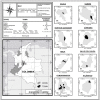Environmental Status of Cryptococcus neoformans and Cryptococcus gattii in Colombia
- PMID: 34073882
- PMCID: PMC8225054
- DOI: 10.3390/jof7060410
Environmental Status of Cryptococcus neoformans and Cryptococcus gattii in Colombia
Abstract
The genus Cryptococcus comprises more than 80 species, including C. neoformans and C. gattii, which are pathogenic to humans, mainly affecting the central nervous system. The two species differ in geographic distribution and environmental niche. C. neoformans has a worldwide distribution and is often isolated from bird droppings. On the contrary, C. gattii is reported in tropical and subtropical regions and is associated with Eucalyptus species. This review aims to describe the distribution of environmental isolates of the Cryptococcus neoformans species complex and the Cryptococcus gattii species complex in Colombia. A systematic investigation was carried out using different databases, excluding studies of clinical isolates reported in the country. The complex of the species of C. gattii is recovered mainly from trees of the genus Eucalyptus spp., while the complex of the species of C. neoformans is recovered mainly from avian excrement, primarily Columba livia (pigeons) excrement. In addition, greater positivity was found at high levels of relative humidity. Likewise, an association was observed between the presence of the fungus in places with little insolation and cold or temperate temperatures compared to regions with high temperatures.
Keywords: Colombia; Cryptococcus gattii; Cryptococcus neoformans; ecology; environment.
Conflict of interest statement
The authors declare no conflict of interest.
Figures




Similar articles
-
Long-term survival of Cryptococcus neoformans and Cryptococcus gattii in stored environmental samples from Colombia.Rev Iberoam Micol. 2015 Jul-Sep;32(3):197-9. doi: 10.1016/j.riam.2014.06.007. Epub 2014 Nov 17. Rev Iberoam Micol. 2015. PMID: 25725529
-
First environmental isolations of Cryptococcus neoformans and Cryptococcus gattii in Tunisia and review of published studies on environmental isolations in Africa.Mycopathologia. 2011 May;171(5):355-60. doi: 10.1007/s11046-010-9381-7. Epub 2011 Jan 1. Mycopathologia. 2011. PMID: 21197581
-
Multilocus sequence typing (MLST) of clinical and environmental isolates of Cryptococcus neoformans and Cryptococcus gattii in six departments of Colombia reveals high genetic diversity.Rev Soc Bras Med Trop. 2020 Sep 11;53:e20190422. doi: 10.1590/0037-8682-0422-2019. eCollection 2020. Rev Soc Bras Med Trop. 2020. PMID: 32935773 Free PMC article.
-
[Cryptococcus species--etiological agents of zoonoses or sapronosis?].Mycoses. 2000;43 Suppl 1:48-60. Mycoses. 2000. PMID: 11098627 Review. German.
-
Environmental prevalence of Cryptococcus neoformans and Cryptococcus gattii in India: an update.Crit Rev Microbiol. 2012 Feb;38(1):1-16. doi: 10.3109/1040841X.2011.606426. Epub 2011 Dec 1. Crit Rev Microbiol. 2012. PMID: 22133016 Review.
Cited by
-
Exposure of Cryptococcus neoformans to Seven Commonly Used Agricultural Azole Fungicides Induces Resistance to Fluconazole as Well as Cross-Resistance to Voriconazole, Posaconazole, Itraconazole and Isavuconazole.Pathogens. 2023 Apr 29;12(5):662. doi: 10.3390/pathogens12050662. Pathogens. 2023. PMID: 37242332 Free PMC article.
-
Gene expression profiles of ERG11, MDR1 and AFR1 in Cryptococcus neoformans var.grubbi from HIV patients.Biomedica. 2022 Dec 1;42(4):697-706. doi: 10.7705/biomedica.6519. Biomedica. 2022. PMID: 36511671 Free PMC article. English, Spanish.
-
Stirring Up Trouble? Forest Disturbance and the Spread of a Fungal Disease.Environ Health Perspect. 2023 Oct;131(10):104003. doi: 10.1289/EHP13649. Epub 2023 Oct 25. Environ Health Perspect. 2023. PMID: 37878795 Free PMC article.
-
SAGA Complex Subunit Hfi1 Is Important in the Stress Response and Pathogenesis of Cryptococcus neoformans.J Fungi (Basel). 2023 Dec 15;9(12):1198. doi: 10.3390/jof9121198. J Fungi (Basel). 2023. PMID: 38132798 Free PMC article.
-
A Landscape of the Genomic Structure of Cryptococcus neoformans in Colombian Isolates.J Fungi (Basel). 2023 Jan 18;9(2):135. doi: 10.3390/jof9020135. J Fungi (Basel). 2023. PMID: 36836249 Free PMC article.
References
-
- Vanbreuseghem R., Takashio M. An atypical strain of Cryptococcus neoformans (San Felice) Vuillemin 1894. Part II. Cryptococcus neoformans var. gattii. nov. Med. Trop. 1970;50:695–702. - PubMed
-
- Kwon-Chung K.J., Boekhout T., Fell J.W., Diaz M. (1557) Proposal to conserve the name Cryptococcus gattii against C. hondurianus and C. bacillisporus (Basidiomycota, Hymenomycetes, Tremellomycetidae) Taxon. 2002;51:804–806. doi: 10.2307/1555045. - DOI
Publication types
LinkOut - more resources
Full Text Sources
Miscellaneous

